Legnica 2010-01-08
Former airport in Legnica.
Geographic coordinates: 51.183N 16.182E. Elevation 121 m.
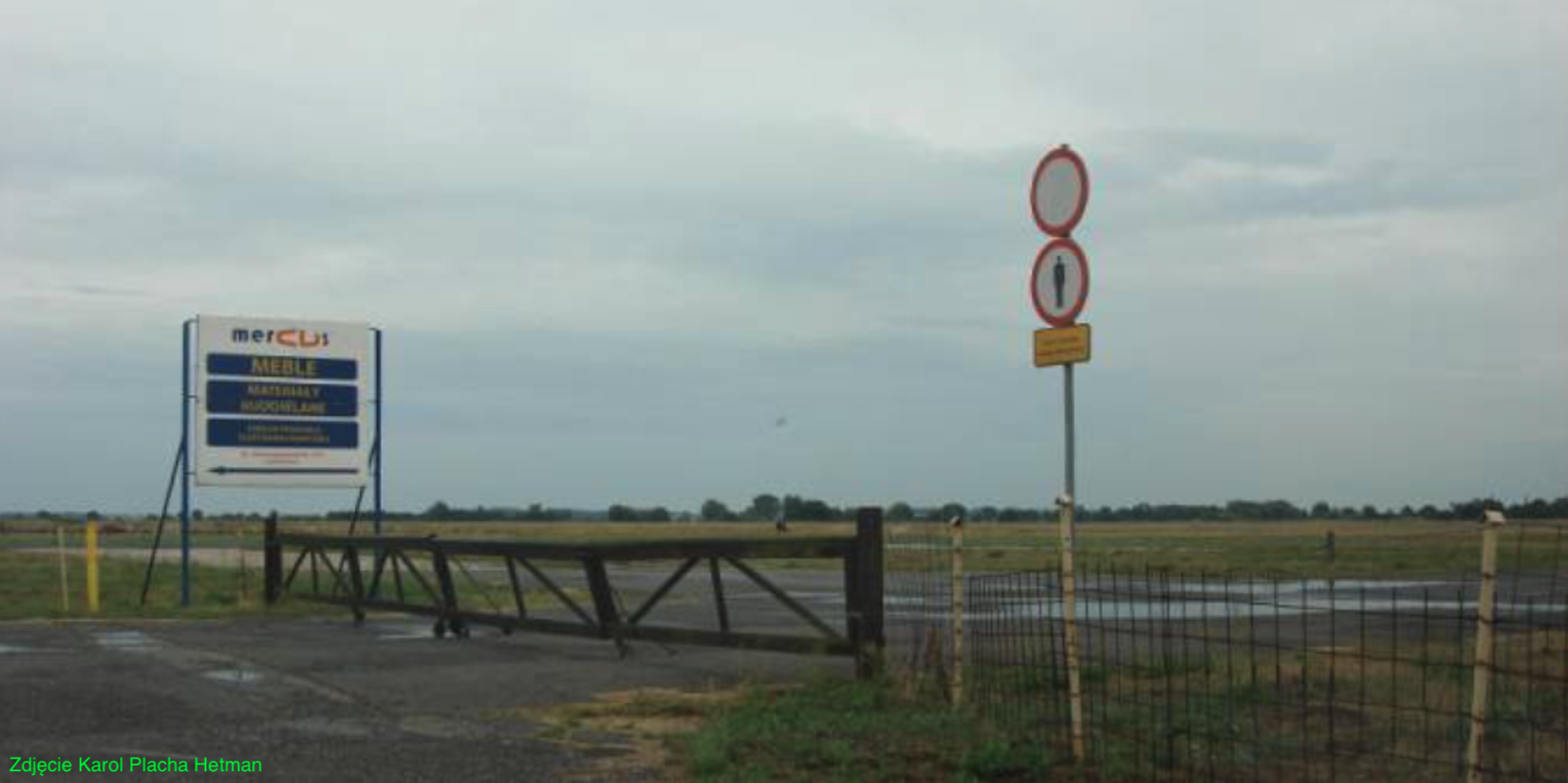

The beginnings of the airport in Legnica.
In 1913, an airport for airships was established in Legnica. Airships have been built around the world since 1852. Airships were essentially propeller-driven balloons. Their shape depended on the amount of gas filling its interior. But at the beginning of the 20th century, Ferdinand von Zeppelin developed a completely new structure, a skeleton covered with impregnated material. That's why airships were often called Zeppelin. This was an innovative solution and allowed the construction of huge airships and, consequently, aerostats with high lifting capacity. The second important element was a higher flight ceiling than the first aircraft. That's why airships were unpunished from a certain point. To this we must add a very large range. That's why they were called airships.
With the start of the Great World War, airships were mainly used for bombing and reconnaissance. However, the effects varied. As it turned out, the only truly successful reconnaissance flight was made from the Legnica Airport. On August 22, 1914, the crew of the SL 2 airship took off to reconnoiter Russian areas. They penetrated the enemy to a distance of 480 km. The flight lasted two and a half days. 1,384 km covered. The soldiers brought, among other things, information about the Austro-Hungarian troops surrounded in the Przemyśl fortress. However, the staff did not appreciate this information, which led to the frustration of the airship crew.
However, airships did not stand the test of time. The reason was great progress in obtaining better and better tactical and technical data for aircraft. But perhaps most of all, it was flammable and explosive hydrogen that filled airships and balloons.
During the Great World War, the first planes appeared at the airport in Legnica. After the end of World War I, the airport fell into oblivion for a short time. At the end of the 1920s, sports planes began to be based here. When Hitler came to power, the airport in Legnica was taken over by military aviation. The airport was developing dynamically. Just before the invasion of Poland, the airport had an area of 220 hectares. Hangars, warehouses, a gas station and railway sidings were built. Internal roads were paved. The squares in front of the hangars were paved. In September 1939, planes took off from the airport and bombed cities in the west of the Republic of Poland.
The flight field was still dirt (grass). But already in 1939, there were plans to build three concrete RWYs in line with the trend at that time. They were supposed to intersect to form an irregular triangle. This was to facilitate the take-off and landing of increasingly heavier aircraft, but with not very powerful power units and with an optimal upwind direction. The first concrete RWY was probably built by prisoners of war around 1940. It was about 1,200 m long. Due to the fact that after the front had moved far to the east, the airport was not treated as strategic, so the financial outlays for its maintenance were low.
The airport in the Soviet period.
The Muscovites took over the property left at the airport. They were particularly pleased with the numerous and undamaged hangars. They allowed the launch of field aviation workshops. The undamaged planes left by the Germans were mostly sent to the east by rail. The biggest problem was the lack of fuel, which had to be imported from CCCP.
Due to the fact that the Muscovites occupied further airfields in the north-west (Krzywa, Szprotawa), no combat regiment had to be based in Legnica. Only in the following years were such regiments temporarily stationed in Legnica. What the Muscovites did to the city determined the character of the airport. It became the third window (rail, road transport) for fast communication with Warsaw, but above all with Moscow. Li-2 transport planes covered the Legnica-Moscow route without stopovers. An-2 type machines were used for communications within the PGW. At the end of the 1950s, Il-18 transport planes began to appear at the airport. In the 60th anniversary of the An-12 and An-24/26 machines. In the 70th anniversary of An-32, Il-76.
Helicopters at the airport in Legnica appeared in the 1950s. Initially Mil Mi-1 (SM-1), then Mi-4, Mi-2, Mi-8 and finally the heavy Mi-6. These helicopters dominated air traffic at this airport. When it comes to fighter planes, they were initially seen here; Jak-1/3/9, MiG-9, Jak-15/17/23. Presumably in the first half of the 1950s, MiG-15 fighters were overhauled here. But in the following years there were no fighters here. It happened that a fighter, for example a MiG-21 or Su-17, landed here, but these were stopovers or emergency landings.
The airport during the Polish.
After the Muscovites left the airport, it was planned that the airport would be taken over by the Polish Army. But due to the constantly decreasing potential of the Polish Air Force, this was unjustified. The airport was handed over to the local authorities. Especially since the airport hampered the city's development.
Before the visit of the Holy Father John Paul II, the airport was very thoroughly examined by sappers to eliminate remaining unexploded ordnance.
Since the airport was taken over by the Polish authorities in 1993, the concept of using the airport for civilian transport, passengers and goods has emerged. The airport manager was SAG S.A. zoo. SAG is an Economic Activity Zone. It is a limited liability company in which the Legnica Commune has 100% of the shares. The company was established in 1992 to manage the airport and adjacent areas. A total of over 200 hectares. The Company's share capital amounted to PLN 7,686,345. The company was entered into the register of enterprises at the District Court Wrocław Fabryczna, 9th Commercial Division of the National Court Register, under the number 0000029353.
SAG's main strengths were; attractive, even perfect location. 1,800 m from the A 4 motorway. 1,500 m from the A 3. 210 km from Prague. Center of the Copper Basin. The vicinity of the Legnica Special Economic Zone. Registered airport.
The first thing that had to be done was to clean up after the Muscovites. Thousands of tons of garbage were removed. Then the installations were built from scratch or modernized; water and sewage, energy and telecommunications.
On April 7, 1999, Legnica Airport was entered into the State Register of Civil Airports, under number 47, as a civil airport with reference code 3 B, with RWY, with an artificial surface.
Over a period of several years, over 20 companies of various sizes have established themselves in the area managed by SAG. They employed a total of approximately 600 people. A large shopping center was built. Already in the period 2002-2005, supermarkets were established in large hangars; Eco, Nomi, Mercus. New ones were built; Auchan and Castorama. The plans also included; Becathlon, Leroy Merlin, Ikea, Makro Cash and Carry, Media Expert, Avans, Neonet, Jysk, Pepco, C&A. Mercus and Gruca started production activities. Companies: EKO - Holding S.A. and Grupa Żywiec S.A. launched logistics centers.
Attempt to maintain the airport in Legnica.
The strategic documents of the Lower Silesian Voivodeship include the need for the operation of the Legnica Airport. In 2001, the Legnica City Councilors adopted the airport operating model included in the document "Concept of the development of the airport in Legnica". However, the document did not propose permanent air connections, which in retrospect was a mistake. On January 28, 2002, the Legnica City Council issued the "Study of conditions and directions of spatial development of the city of Legnica". In it, the airport was indicated as a positive element of impact on the City. But not even a proposal for its future infrastructure was provided.
The local press several times presented information and broader articles about the possible restoration of the airport. But the basic condition was to find a strategic investor. Opponents argued that the condition of the surface of RWY and DK was bad and that landing could damage the plane. The last renovation was carried out in 1986. The Mayor of the city, Mr. Tadeusz Krzakowski, was a supporter of making it an economic and industrial zone, which obviously led to the liquidation of the Legnica Airport. One of the arguments was the Wrocław Airport, to which the inhabitants of Legnica have an excellent motorway connection. "The area after the airport is to generate money for the City through the Legnica Special Economic Zone." In May 2003, Strefa Activity Economic Sp. z o. o. was accepted as a member of the Association of Regional Airports.
In 2005, a new player appeared in the Legnica Airport topic; Airblu company. It was an international consulting and design company. The proposal was to create a joint Polish-Italian-Dutch project providing for obtaining EU structural funds to create an airport-based logistics center in Legnica. Airblu's president, Alberto Denzler von Both, presented the main assumptions of the idea. But there were no details. It was known that the new company was to be of a municipal-private nature. The city was granted 51%. Theoretically, everything depended on Brussels. Unfortunately, Airblu turned out to be financially unreliable and the plans fell through.
In 2007, an analysis of the Legnica Airport was carried out by the Polish-Irish consortium "Pol-Consult". The analysis was commissioned by the City authorities. "DEVELOPMENT OF THE AIRPORT AREA IN LEGNICA." The analysis confirmed the validity of maintaining the airport. It has been shown that it will develop successively and bring significant income, with expenditure on its launch and modernization of PLN 16 million.
The "Air Logistic Legnica" company submitted an offer to the Mayor of Legnica for the development of the airport. The company meets all airport management requirements specified by aviation law. Its offer includes taking over the management of the airport areas through lease, while the City retains the function of the owner. It would be necessary to apply for EU funds. It is worth noting that so far no one from the Legnica authorities has applied for such funds (!). Moreover, the current manager of the airport, SAG, submitted an application to the Civil Aviation Office for the liquidation of the airport.
In 2008, discussions about the future of Legnica Airport continued. President Tadeusz Krzakowski sought to transform the airport into investment areas. And this would mean the end of airport restaurants. Only thanks to the great determination of the councilors, there was still a chance for the Airport. At that time, the distribution of votes of Legnica councilors was as follows; 14 for the airport, 8 against the airport, 1 abstention. The problem was still complex. Creating more workplaces in the Legnica area was not a good idea. There was already a shortage of workers. At that time, the Legnica region was among those with the lowest unemployment.
On January 2, 2008, a NOTAM was issued informing about the closure of the Airport for a period of two years. Until December 31, 2009. (NOTAM in English NOTICE TO AIRMAN - Notice of the Air Chief, it is a notice with information about the creation or change of devices, procedures or services, or any other danger, the disclosure of which is important for those interested). The National Air Navigation Agency issued a NOTAM: EPLE LEGNICA - closed to air traffic.
Air Logistic Legnica was established in June 2008. Its goal was to open the airport in Legnica. The company wanted to create a regional airport. Take care of passenger and cargo transport using your own aircraft. Initially two. Glider training was also planned. The government program for the development of regional airports for the period 2007-2013 was supposed to be an opportunity. Nothing came of it.
What successes could SAG boast in the field of aviation? Unfortunately, there wasn't much of it. In cooperation with the Jelenia Góra Aero Club, a glider course was organized (probably once), the students of which obtained the third class of a glider pilot. Paragliding training was organized. Modelers used the airport. It is also difficult to consider SAG's ideas of transporting passengers by coach from the Legnica terminal to the Wrocław Airport as creative.
On June 24, 2010, a conference entitled "Legnica against the background of the regional communication potential of Wrocław Airport" was held at the Qubus Hotel. It was organized by: the Mayor of Legnica, the President of the Management Board of Wrocław Airport SA and the Economic Activity Zone managing the area of the Legnica airport. Over 50 people participated, including: with the aviation industry, economic and business circles and a group of councilors of the Legnica City Council. The conference showed that the airport in Legnica has minimal potential.
On October 24, 2016, by resolution of the City Council, the airport was closed down and the area after the facility was designated for production and service activities. Legnica Airport has gone down in history.
Infrastructure of Legnica Airport.
Geographic coordinates: 51.183N 16.182E. Elevation 121 m. ICAO code; EPLE. Radio Frequencies: Port 122.55 MHz. Legnica Info. 125.55MHz. Contact; tel. (076) 721-01-38. On April 7, 1999, Legnica Airport was entered into the State Register of Civil Airports, under number 47, as a civil airport with reference code 3 B, with RWY with a hard surface. One DS with dimensions of 1,600 m x 40 m. Load capacity; PCN 38/R/B/W/U. The airport was closed to air traffic on January 2, 2008.
Runway (RWY) with dimensions of 1,600 m x 40 m, located in the direction 08/26. It received its dimensions in the 1950s. Concrete surface. Area 64,000 square meters. Previously, the length was about 1,200 m and the width was 20/25 m. According to available knowledge, in Germanic times there were two more runways planned, which were supposed to run more or less like the current main DK. Currently (2009), in addition to the concrete RWY, the Airport had an emergency dirt (grass) runway, located parallel to the main one on its southern side. Its dimensions were 1,400 m x 100 m.
Taxiways. Approximately 4,000 m of DK was built at the airport. They were 10-20 m wide. The area was 72,000 square meters. Their surface is concrete or asphalt.
The specific feature of the airport were large PPS intended for single large Mi-6 helicopters. There were 31 such positions and 24 remaining.
The airport is equipped with only one CPPS with dimensions of 150 m x 50 m and an area of 7,500 square meters.
Hangars at the Legnica airport.
The airport had a large number of hangars. Most of them were created during Germanic times. Unfortunately, we do not know their actual numbers, so we created our own numbering, starting from west to east. Let us remind you that hangars are not garages for airplanes. They usually served as workshops, where mechanics and the aircraft itself have favorable conditions.
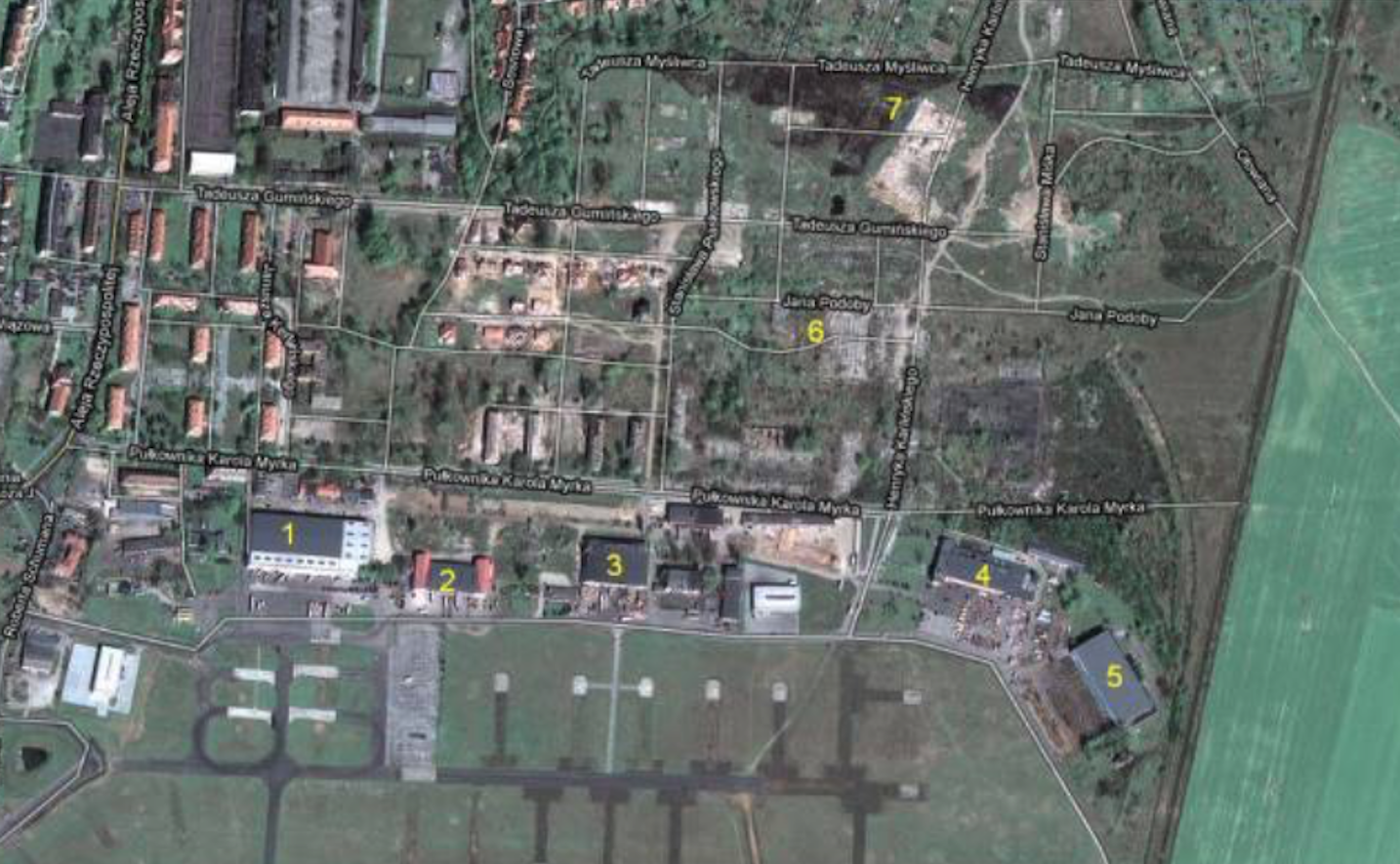
Hangar No. 1. This hangar no longer exists. It was completely rebuilt into the EKO Logistics Center, and later occupied by Dorfner Minerals Polska. The dimensions of the facility have been significantly enlarged. Both towards the south and west. Only from photos taken from the air can you see how large the hangar was. It had dimensions of 95 m x 45 m.
Hangar No. 2, at the time of its construction, was one of the most modern facilities of this type. The hangar and two support buildings are enclosed in one block. Its base is 80 m x 45 m. The hangar also belonged to the EKO company, and currently houses the company "Mooij Forwarding & Logistics.
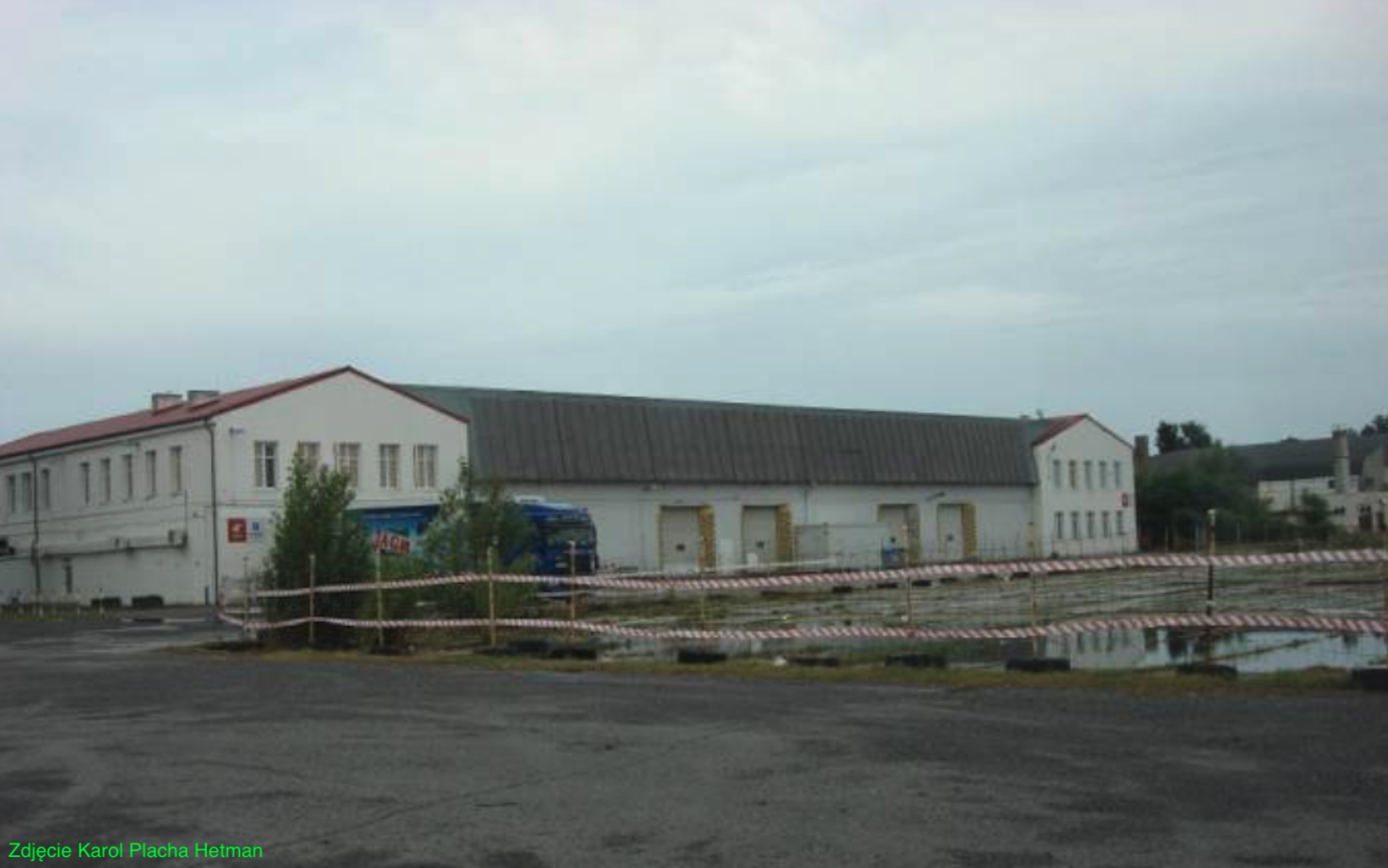
Hangar No. 3 is a structure probably built in 1935. It is distinguished by a variable-curved roof, huge chimneys and a clock placed on the pediment in the gable. The hangar measures 74 m x 55 m at its base. Currently, it houses a vulcanization plant.
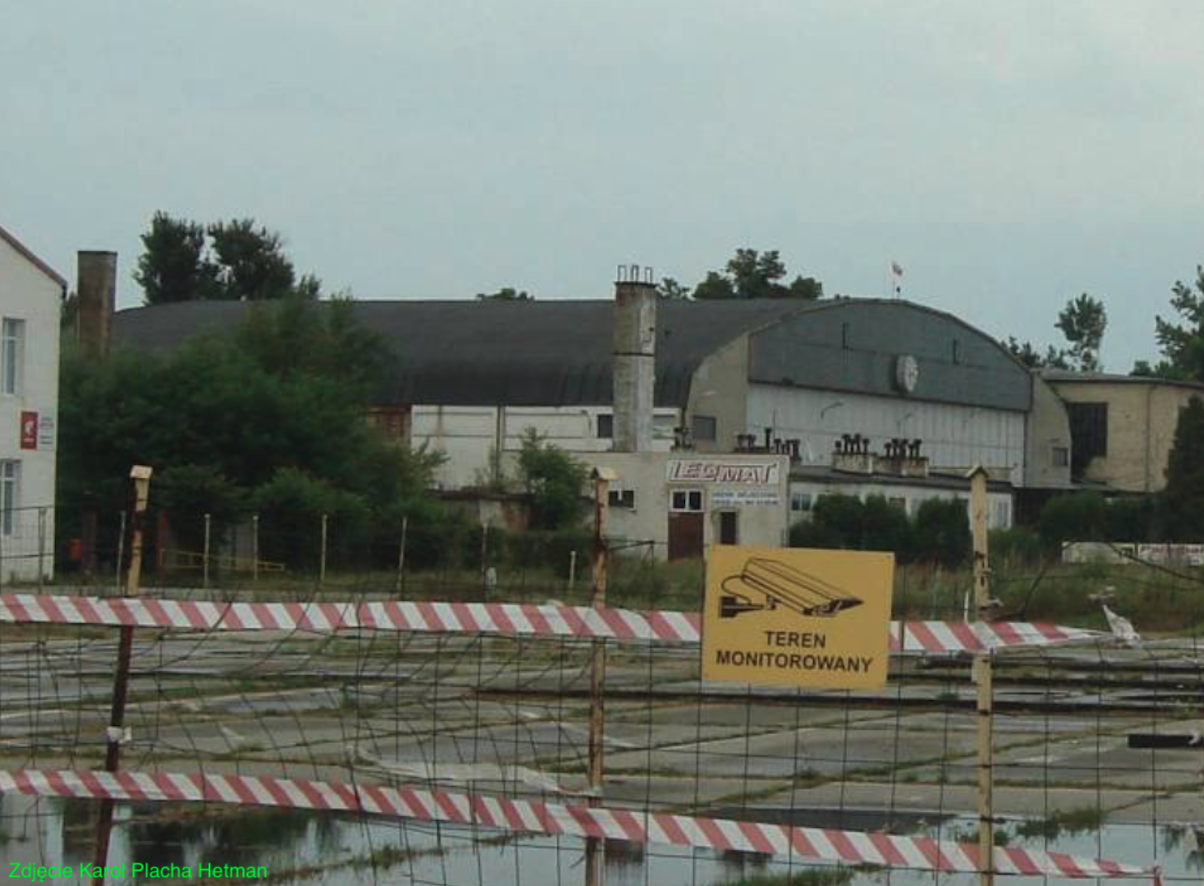
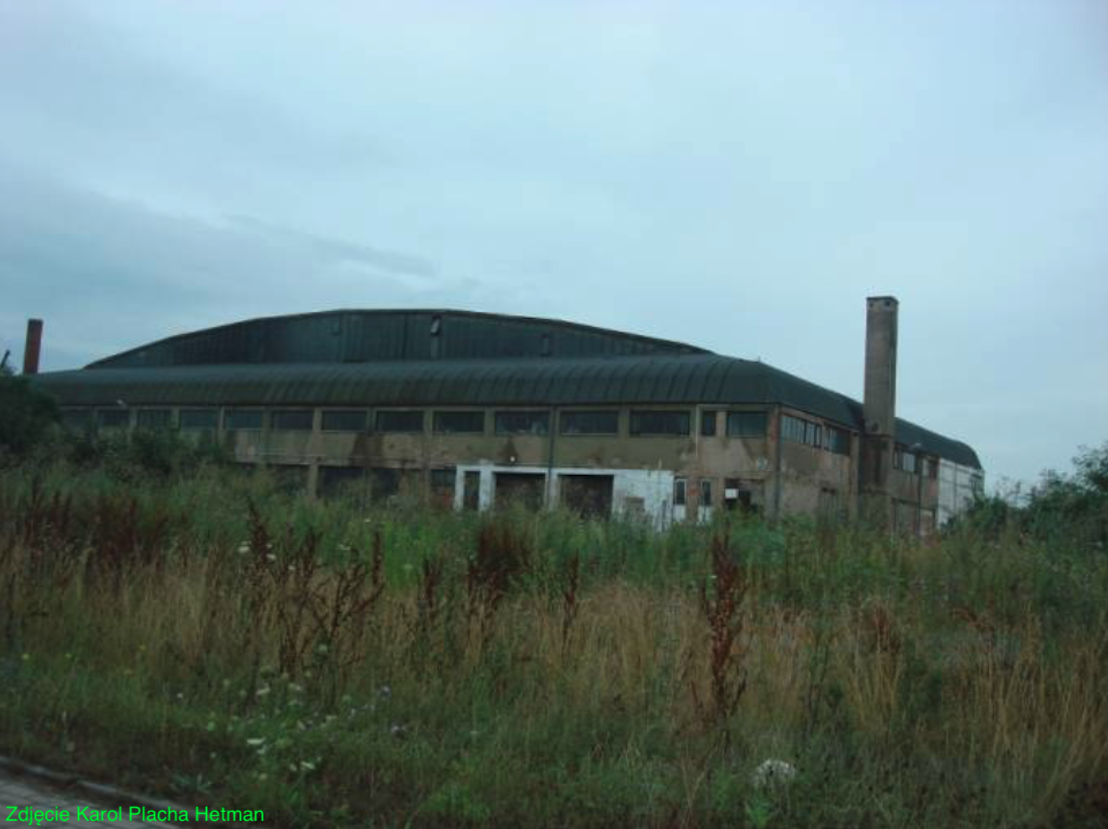
Hangar No. 4 is one block with the air traffic control tower. The hangar itself has a base area of 70 m x 40 m. The facility is also developed by companies. It houses the ISO Trade Spółka online store and the Fffrree.com company.
Hangar No. 5 is the westernmost facility. He is the youngest. Presumed to be built in 1975. The new owner in 2009 performed a major renovation. The hangar measures approximately 85 m x 45 m at its base. Currently, the hangar is occupied by Ready Bathroom.
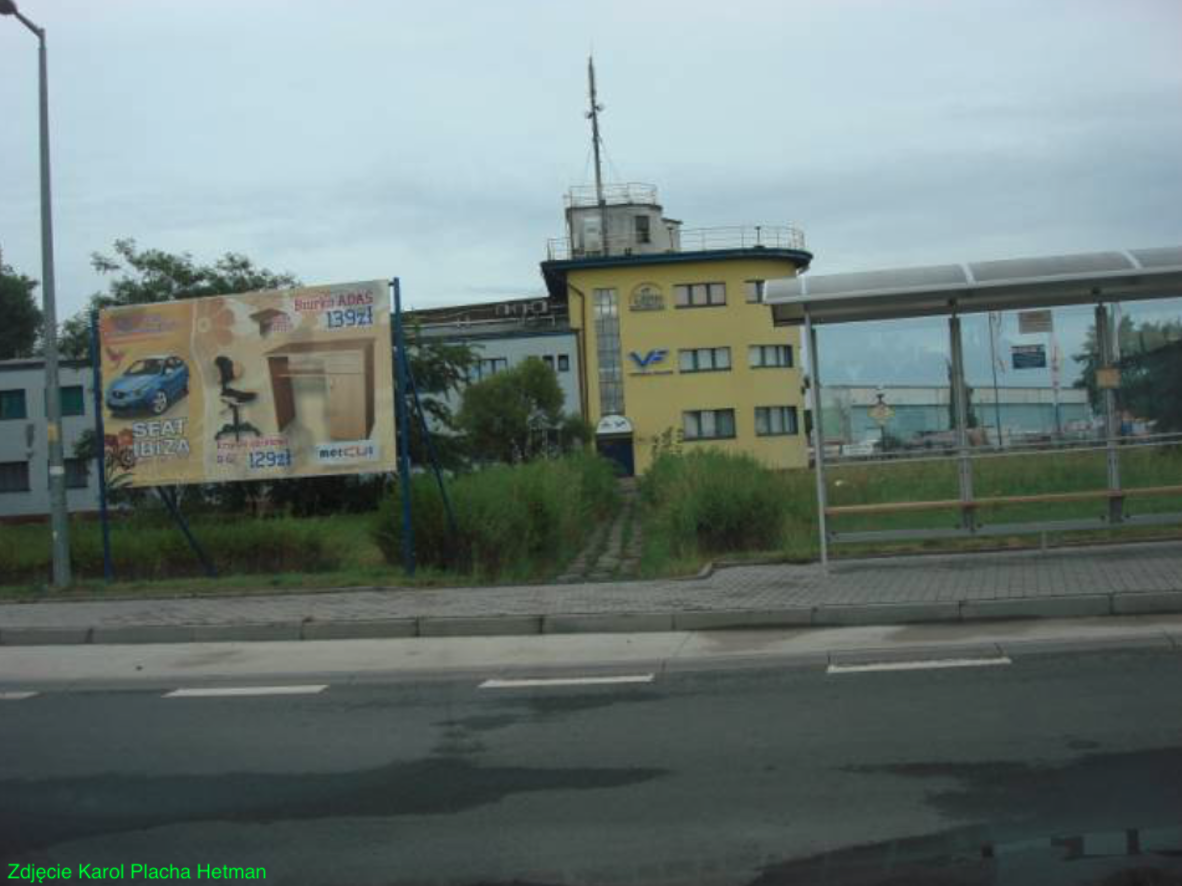
The hangars mentioned above were lucky and found buyers after a few years. They were occupied by various companies as warehouses and commercial pavilions. Other buildings also found new hosts. Unfortunately, the hangars located away from RWY, in the north-eastern part of the airport, were not so lucky. Abandoned, they had no owners and became more and more devastated every year, and were finally demolished.
Hangar No. 6, with base dimensions of 80 m x 40 m. The structure of the walls is made of bricks. The roof has a riveted truss structure, covered with sheet metal. Windows with glass on the sides cannot be opened. Multi-element metal doors, opened manually. Inside, in the right corner, there are three brick garages with technical ducts.
Hangar No. 7 was located furthest to the south-east. It was bigger. The base was 90 m x 40 m. Its structure was identical to hangar No. 6. Also in 2001, it was demolished.
Other airport facilities.
Due to the development of the airport, the air traffic control tower was relatively far from RWY. This proves the time of its construction before the concrete main RWY was built. It is a four-story building that has been modernized several times during its existence.
The MPS is located in the southern part of the airport. There was a road and a railway siding leading to it.
Military facilities at the airport include a bomb depot (weapons warehouse). Did the Soviets store nuclear (atomic) weapons there? We can write that no, because there were no planes to transport them at this airport. But bombs and missiles were definitely stored here.
The fence of the Legnica Airport was typical of Germanic and Soviet solutions. They can be found in Brzeg, Kluczewo and others. Reinforced concrete posts and barbed wire stretched between them. Only some parts of the airport fence were fenced with concrete. Especially those from the City side. Additionally, there were a few warning signs in Russian. While breaking through such a fence was not a problem, it would be easy to come across guards whose posts were placed every 200 m. The entire airport was heavily defended. Not only through a large number of armed guards, but also through numerous watchtowers-bunkers. These were typical Soviet solutions based on reinforced concrete prefabricates assembled like blocks. Many of them were partially hidden in the ground. Such a bunker was equipped with firearms, heavy machine guns and heavy machine guns, as well as grenades.
Railway and sidings.
We have already mentioned the railway siding. In terms of rail transport, the airport is unique. Because behind its fence, on the eastern side, there is railway line No. 137, a single-track line from Legnica to the town of Jawor and further to Katowice. In the territory of the Republic of Poland, airports are usually accessed by railway sidings several or even several kilometers long, built especially for the needs of a given airport. The Legnica – Jawor railway line is currently used to a minimal extent. There are three sidings at Legnica Airport. One leading to MPS and two in the north-eastern part, near hangars and warehouses. A significant part of this track has already been demolished.
The construction of the railway route No. 137 Legnica-Katowice began in 1844. In 1957, the route began to be electrified. The section between Legnica and Jawor was also electrified, but the overhead contact line was dismantled on the orders of the Muscovites (!).
The airport facilities in Legnica.
The entire northern part of the airport was occupied by headquarters and barracks buildings. They are located between today's streets of Colonel Karol Myrek (an outstanding Polish artillery commander) and Tadeusz Gumiński. Currently (2010), a significant part of these buildings has been adapted for residential purposes and renovated. But there are still several buildings waiting for renovation or demolition. In the following years, the vacant land was parceled out and a housing estate of single-family houses was built.
Main entrance to the Airport.
Of course, the main entrance to the airport is not a very interesting object. But it is interesting in terms of its systematic disappearance, and currently there is no trace of it. The gate was located at the intersection of Rzeczypospolitej and Pułkownika Karol Myrka avenues. First there was a metal gate, a pass office and a bunker. In 1994, the gate was decommissioned. Then the bunker was demolished, the street was widened, and the intersection was equipped with traffic lights. A pedestrian crossing was built in the pass office building. And after several years, the building was demolished. fragments of the old concrete fence were also removed. The "Dino" shopping pavilion was built next to the intersection.
Written by Karol Placha Hetman
